Double Star of the Month Archive 2022
In this series of short articles, a double star in both the northern and southern hemispheres will be highlighted for observation with small telescopes, with new objects being selected for each month.
December 2022 - Double Star of the Month
47 Tauri = BU 547 (04 13 56.39 +09 15 50) could be be described as a typical Burnham discovery. The stars are both unequal and close, a type of visual binary that Burnham seemed particularly adept at finding.
The V magnitudes are 5.1 and 7.3 and at present they are 1".3 apart in position angle 339 degrees. They have moved slowly apart since discovery and seem likely to continue this trend for some years to come.
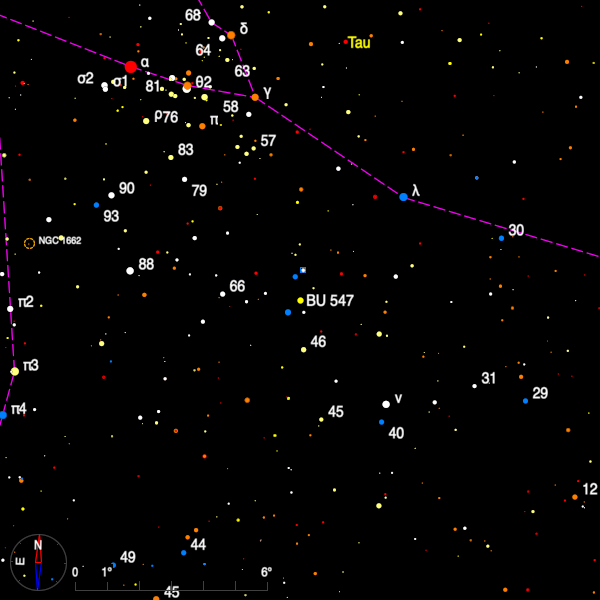
Hipparcos determined a parallax of 9.83 mas for the whole system whilst Gaia DR3 contains only the results for the primary star. This comes in at 7.96 mas.
I was able to measure the pair on 2 nights in 1993 using the 8-inch Cooke refractor at Cambridge Observatories, but it was not an easy object. 47 Tau is about 8 degrees south-west of Aldebaran and sits in a low power field with magnitude 4.3 mu Tau. A good 6-inch should show the stars which have been allocated a preliminary orbit of 479 years.
The Washington Double Star (WDS) catalogue also lists an unassociated field star of magnitude 13 which is at 228 degrees and 28".
SKF 949 (03 53 33.33 -46 53 37.2) came to the attention of Brian Skiff at Lowell Observatory whilst examining stars in Nancy Houk's spectral type reclassification project in order to add to his extensive collection of spectral types.

Examination of Vizier showed a common proper motion companion, V = 8.5 and spectral type G, some 76" distant from the K2III primary which has V = 6.1. and which is almost due south of its companion. Gaia DR3 confirms that the stars have similar parallaxes, indicating that they are 359 light-years distant.
This is an easy pair for the small telescope and may even be visible in a pair of suitable binoculars. The system is in a unremarkable area of Horologium, about 6 degrees south-west of alpha.
Bob Argyle - Double Star Section Director
November 2022 - Double Star of the Month
In the corresponding column for this month in 2021, I mentioned a number of pairs close to the bright, close binary phi Andromedae. As promised this piece will include the pairs MAD 1 (01 00 35.58 +47 19 14.6) and STT 21 (01 03 01.54 +47 22 34.1).
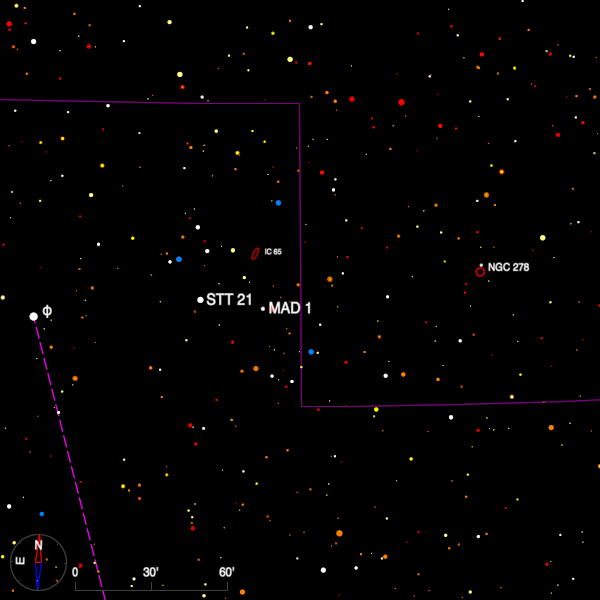
STT 21 is about 1.5 degrees west of phi And and is now considerably easier to observe than in the 1840s when the separation was 0".6 The current orbit of 450 year period was published by W. D. Heintz in 1966 and predicts a position of 176 degrees and 1".2 for late 2022. The apparent orbit is one of high eccentricity and inclination and the apparent motion appears to be almost linear. The magnitudes are 6.8 and 8.1 and the pair should be resolved in 15-cm aperture.
Johann Madler (1794 - 1874) succeeded F. G. W. Struve as Director of Dorpat Observatory where the main instrument was Fraunhofer's 9.3-inch refractor with which Struve had carried out his great survey of double stars. MAD 1 can be found half a degree west of STT 21. It is a long period binary with main components of magnitudes 7.7 and 9.1. When first observed the separation was 1" but the stars have been closing slowly and at the present time are 0".74 apart in PA 356 degrees, if the 2127 year orbit currently in the catalogue is accurate.
HJ 5437 (00 00 34.35 -53 05 51.8) sits in southern Phoenix 20 arc-minutes to the south-east of the red giant pi Phe (V = 5.1).

It is not labelled in the second edition of the Cambridge Double Star Atlas, and was found by John Herschel in 1836 at 340 degrees and 2".5 since then has been slowily closing. In 2019 the stars were at 340 degrees and 1".4 and as the magnitudes are respectively 6.9 and 9.9 this is a rather difficult pair which probably needs at least 20-cm.
Although the observed motion only amounts to 44 degrees, a premature orbit with a period of 904 years is listed in the online USNO 6th orbit catalogue. Incidentally the USNO double star website is back on-line and can be found at crf.usno.navy.mil. The WDS catalogue is available again but the latest update appears to have been about 2 months ago.
Bob Argyle - Double Star Section Director
October 2022 - Double Star of the Month
Just to the north-east of the Blue Snowball Nebula, NGC 7662, in Andromeda is an asterism of naked-eye stars in the shape of a `Y'. The star at the position where the figure forks is kappa And and just half a degree to the west is STT 500 (23 37 32.53 +44 25 44.5).
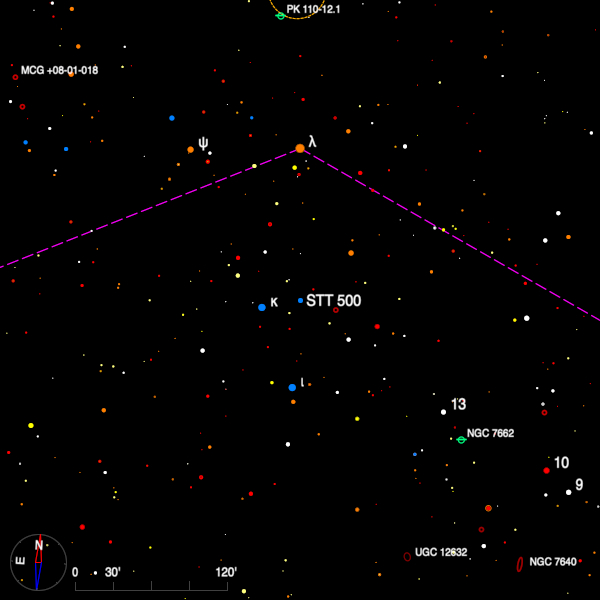
This is a long-period binary, a preliminary orbit computed in 1981 gives a period of 351 years, and an aperture of 25-cm is probably needed to divide the stars. The V magnitudes are 6.1 and 7.4 and when the binary nature of the system was discovered in 1843 by Otto Struve at Pulkovo, the stars were 0".3 apart and at a position angle of 273 degrees. They are currently separated by 0".4 and they have moved around to a position angle of 21 degrees.
Gaia DR3 has an entry for the brighter star but no data on parallax and proper motion. The Hipparcos satellite gave a distance of 807 light-years but with a formal error of 104 light-years. At a distance of 118" and a position angle of 334 degrees is a more distant star of V = 11.0.
DUN 249 (23 23 54.52 -53 48 31.5) is located in the extreme SE corner of Grus and about 2.5 degrees due east of kappa Gruis. Like many other pairs in the Dunlop catalogue this is a wide and bright pair, easily seen in the smallest of apertures. I measured it using the 26.5-inch refractor at Johannesburg in 2016 when the position angle and separation were 211 degrees and 26".4 respectively.

Gaia DR3 gives distances of 408 and 494 light-years for the stars which, nevertheless, have very similar proper motions. The errors on the parallaxes nowhere near overlap so it seems that these stars are not connected physically.
Head 3 degrees north and there is a line of DUN pairs stretching along the 51st parallel of south declination including DUN 246, DUN 248 and DUN 250.
Bob Argyle - Double Star Section Director
September 2022 - Double Star of the Month
I noted, rather surprisingly, that this column had yet to deal with gamma Delphini (20 46 39.50 +16 07 27.5) so this is a good opportunity to do so. One of the finest pairs in the sky because of its glorious colours, gamma has been known since the time of James Bradley (1755).
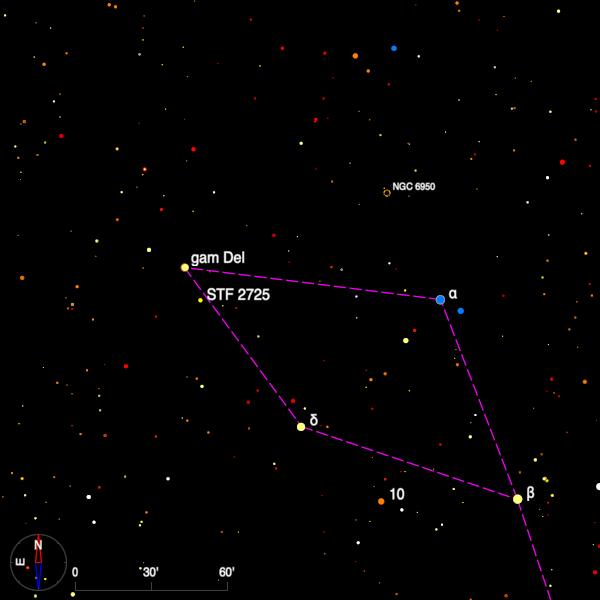
The stars are magnitudes 4.4 and 5.0 and they are currently 8".8 apart in position angle 264 degrees. Although there has been little motion between the two since Bradley's time, an orbit with a period of 3249 years has been calculated which predicts a closest approach of 0".8 in around 2300. The apparent orbit as plotted in the USNO 6th orbital catalogue shows little, if any, sign of orbital curvature but the stars have the same parallax, if only just.
The results of radial velocity observations of both stars with the intention of finding exoplanets have not confirmed any.
Smyth observed the pair on many occasions and found colours of yellow and light emerald, whilst I made them golden yellow and blue-green when I first observed them during a youthful survey of double stars in 1968. Thirty arc-minutes south preceding gamma is the pair STF 2725, also a long-period binary. It has stars of magnitude 7.5 and 8.2 at 12 degrees and 6".2.
Right on the border between Sagittarius and Microscopium, R 321 (20 26 52.95 -37 24 10.5) is a fine binary which is well worth sweeping for.

Found by H. C. Russell at Sydney Observatory, this pair has a period of 186.4 years and the motion of the stars is in decreasing position angle (retrograde). In 1880, when first observed, the stars according to Russell were 1".1 apart , then by 1950 they had closed up to 0".26 before later opening out. At the present time they are 1".6 apart, with widest separation occurring around 2029. The stars have visual magnitudes of 6.2 and 7.9 and are orange in hue - each is an early-K dwarf. They should be comfortably divided with 10 or 12-cm.
Whilst in the area, move about 3 degrees SSW, and you will find DUN 230 (20 17 49.68 -40 11 05.1) which is an easy object for the smallest aperture. The two components are both of late-F spectral type and whose visual magnitudes are 7.4 and 7.7; the stars are 9".7 apart in PA 117 degrees, and lie 257 light-years away.
Bob Argyle - Double Star Section Director
August 2022 - Double Star of the Month
In the column for August 2019, I described 16 Cygni, a bright and easy double foundabout 6 degrees north of delta Cygni. Starting with 16 Cygni, and moving west about 5 degrees a coarse triple of 6th magnitude stars will appear in the finder field. The easternmost of these is STF 2486 (19 12 05.03 +49 51 20.7) which consists of stars with V = 6.5 and 6.7 which are currently 7".1 apart in position angle 202 degrees.
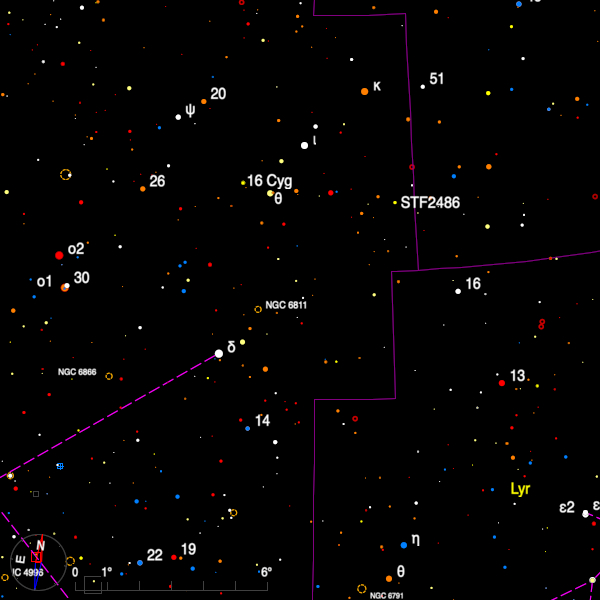
This is a relatively nearby (82.5 light-years) binary pair whose period has been found to be 1459 years but clearly this is a preliminary value, since the position angle has decreased but 21 degrees since 1819. The proper motion of the stars is more than 0".6 per year, so they are rapidly leaving behind star D (V = 11.1) at 196", but rapidly approaching star C which is V = 13.2 at 27".
Sir William Herschel's third and last catalogue of double star discoveries includes many pairs which are low in the sky from the UK, and two of them were found close to omicron Sagittarii.
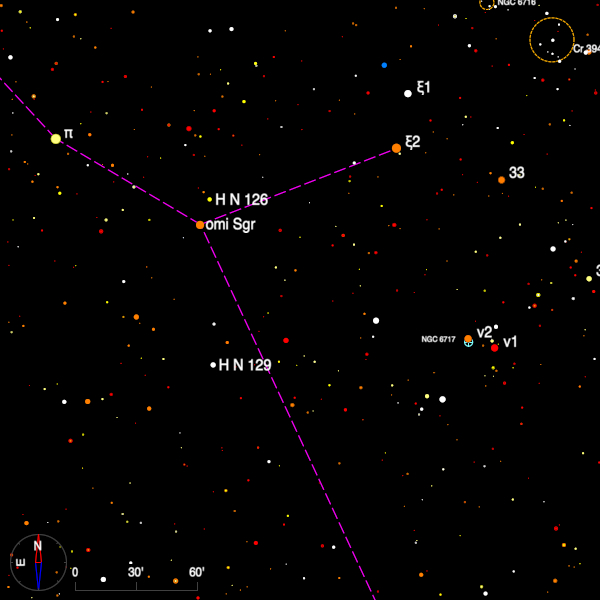
The first of these, H N 126 (19 04 20.28 -21 31 53.7), is the more difficult of the two. It is about 15 arc-minutes NW of omicron and consists of stars with magnitudes 7.9 and 8.1 which are currently 1".3 apart in PA 183 degrees. This binary has almost completed 270 degrees of its apparent orbit since discovery, has an orbit of about 502 years, and lies 168 light-years distant.
About 1.25 degrees due south of omicron is H N 129 (19 04 14.20 -22 53 47.5), significantly easier at 309 degrees and 8".3, but with two components which are considerably unequal (V = 6.9 and 9.2).
Bob Argyle - Double Star Section Director
July 2022 - Double Star of the Month
Delta Serpentis (15 34 48.14 +10 32 20.0) is a bright, easy, and attractive pair in small apertures. It lies in a rather undistinguished part of the sky below Corona Borealis and a quick way to find it is to locate alpha CrB and then move 16 degrees south in declination.
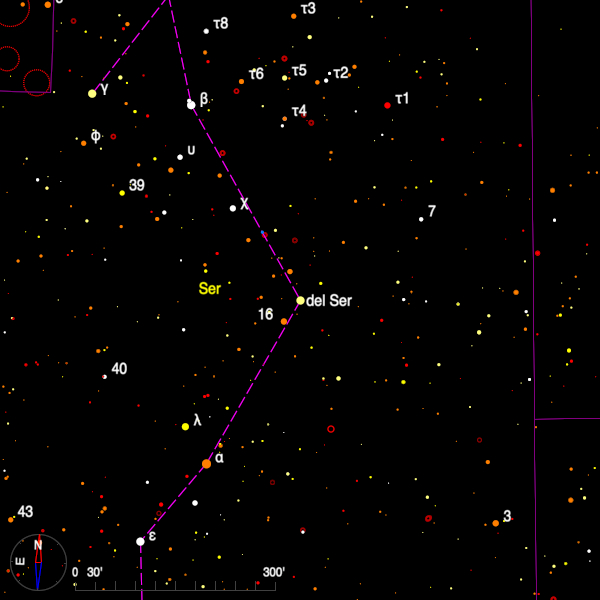
Since it was found by Herschel in 1782, when he noted that it was a fine double star with colours of white and greyish, it had been slowly widening until about 2020 since when it has begun to close.
Looking at the apparent orbit, there is no question that this is a binary system and yet Gaia EDR3 puts the stars at 302±14 and 172±1 light-years respectively for the primary and secondary components. Neither of these stars appears in the Hipparcos catalogue and the large error for the primary star suggests that it may be a system of higher multiplicity. The plot of the apparent orbit in the Washington Double Star (WDS) Sixth Orbit Catalogue shows rather large errors on the earlier observations of this pair which are difficult to reconcile with the ease of measurement that such a system should present, again possibly evidence for an oscillation in the movement of one of the stars.
I have made eight sets of mean measures since 1993 and the separation has ranged between 3.94 to 4.43 arc-seconds. The orbit gives 171 degrees 4".0 for mid-2022.
H.F. Donner was a student at the University of Michigan when he was sent out to South Africa to assist Robert Rossiter with the survey for southern double stars at the Lamont-Hussey Observatory in Bloemfontein using a 27-inch refractor. He stayed for 6 years and accumulated a total of 1030 new pairs, many of which are faint and close. Xi Ophiuchi (17 21 00.37 -21 06 46.5) is number 832 in his catalogue of discoveries.

The primary magnitude is V=4.4 and companion V=8.9. This is a difficult pair for the small aperture and probably needs at least 15-cm to see distinctly. The current separation is only 1".7 with the corresponding position angle 20 degrees. A orbit was calculated with a period of 421.5 years which is clearly rather premature since the motion since discovery amounts to only 40 degrees.
There is a very faint star at 261 degrees, 11" which is K=13.7 and was discovered during an imaging survey for exoplanets with the 200-inch reflector, but it remains unconfirmed and there is no subsequent astrometry.
Bob Argyle - Double Star Section Director
June 2022 - Double Star of the Month
Gamma Herculis (16 21 55.24 +19 09 10.9) appears in William Herschel's first double star catalogue as H V 19. Gamma is easily found as it sits just 3 degrees SW of the most south-westerly star, beta, in the Keystone of Hercules.
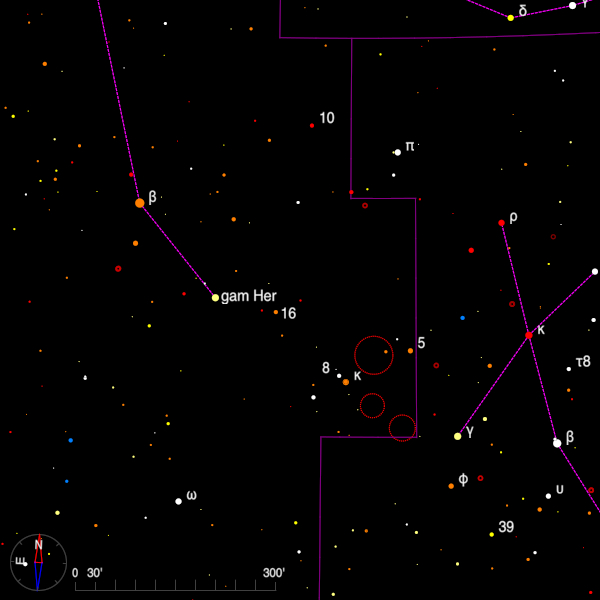
It is a late-A giant star of magnitude 3.8 and in 1780 Herschel found a magnitude 10 companion at 251 degrees and 41".8. By 2013 the position angle had reduced to 226 degrees and the separation was 43".3. This change is due entirely to the difference in proper motions. The Gaia satellite finds the primary star is 193 light-years away whilst the companion is more than 1,770 light-years distant. An additional optical companion, of V = 13.3, can be found at 298 degrees and 82" from B.
The Washington Double Star Catalog (WDS) states that A is a spectroscopic binary, but it does not appear in the Ninth Catalogue of Spectroscopic Binaries (SB9), compiled by the late Dr. Dmitri Pourbaix. Additionally an infra-red survey has revealed an object 8" from A which has a K magnitude of 8, and thus a V magnitude of perhaps 10-11. Whether it is connected to A is not known.
Eta Lupi (16 00 07.33 -38 23 48.1) is a hot, early B-type star of magnitude 3.4 which lies in Lupus, 16 degrees due south of delta Sco, the middle of the three bright stars in the Scorpion's head. Eta is part of the Upper Centaurus - Lupus association and thus has a similar distance (460 light-years) and proper motion to a group of stars in the neighbourhood.

The WDS shows three companions, two of which have similar parallaxes to eta, and all of which appear white in the eyepiece. The B component is magnitude 7.5 at a distance of 14" and position angle 19 degrees, a relative position which has changed little since the pair were first noted by Rumker from Parramatta. C is magnitude 9.4 at 115" and PA 248 degrees. This star was also noted by Rumker who appears to have estimated a distance of 1 arc-minute but this may be in error (possibly a misprint for 2 arc-minutes?) as the star moves through space together with the brighter components. The star listed in the WDS as ANT 2 AD (the designation refers to Rainer Anton who measured the previously uncatalogued component D in 2007) does not appear to belong to the association and is almost four times more distant. It can be found at 293 degrees and 136".
Searching the Gaia EDR3 catalogue within a radius of 200 arc-seconds from eta shows a magnitude 14 star which also moves with, and is equally distant from us, as A, B and C, and which can be found at 290 degrees and 118".
Bob Argyle - Double Star Section Director
May 2022 - Double Star of the Month
In the second edition of the Cambridge Double Star Atlas, SHJ 191 (14 59 34.58 +53 51 36.7) is the most northerly labelled double star in the constellation of Boötes and lies just over a degree south of the border with Ursa Major.

It was measured by Sir James South on 1823, April 27 and again on May 3 of that year using his 5-foot equatorial and he found the mean separation to be 40".85 (the text in the catalogue gives 48".85) and the mean position angle 343° 10'. These values are little changed today and whilst the proper motions determined by Gaia in the EDR3 catalogue are similar, the parallaxes appear to be significantly different, with 9.590 ± 0.122 mas for the A component and 8.875 ± 0.015 mas for B. The large error for A may indicate additional structure.
The Washington Double Star Catalog (WDS) gives magnitudes of 6.9 and 7.6 for A and B and both stars are F1 dwarfs. An interesting feature in the finder chart plotted using SIMBAD is the presence of a nearby pair of faint red stars and which are described at greater length in the upcoming Double Star Section Circular (DSSC) Number 30.
One of S. W. Burnham's more attractive pairs for the small telescope is mu Lib - also known as BU 106 (14 49 19.09 -14 08 56.3). It is easy to find sitting just 2 degrees north and slightly west of Zubenelgenubi, or alpha Cap, which is, in turn, a fine very wide pair, the stars being 376" apart.

Mu Lib was discovered by Burnham with his 6-inch Clark in 1873 when the stars were separated by 1".3, and since then they have slowly separated (currently 1".9) with a change in position angle of just 27 degrees, even so an orbit exists for the system with a period of 614 years. A and B have V magnitudes 5.6 and 6.2 and whilst the A component does not appear in EDR3 the B star has a measured distance of 245 light-years. A magnitude 12.6 star lying at PA 232 degrees and 27" from A has the same parallax and would appear to be physically connected to the binary pair.
Bob Argyle - Double Star Section Director
April 2022 - Double Star of the Month
The two pairs in this month's column have a common feature. Each is accompanied at a distance by a ninth magnitude companion.
STF 1781 (13 46 06.75 +05 05 56.1) is a visual binary with a period of 179 years which is 206 light-years away, according to Gaia EDR3. It can be found in Virgo, near the border with Boötes, about 2 degrees NE of 84 Vir, itself a double star (5.6, 8.3, 227 degrees, 2".7).

Although the components of STF1781 are rather faint (V magnitudes are 7.9 and 8.1) the current position, 200 degrees and 1".1, indicates that the stars should be resolvable in 15-cm aperture. They are currently closing and by 2050 they will be separated by 1".2. I have not observed this system - in the late 1970s the stars were less than 0".3 apart and have been widening ever since. More recently Dr. Andrei Tokovinin found a common proper motion companion of magnitude 9.8 at PA 128 degrees and distance 1594".
The primary of JC 16 (11 29 38.35 -24 27 50.6) is just above naked-eye visibility at V = 5.8. Eight arc-seconds away in PA 82 degrees is the B component of V = 8.6. The catalogue number tells us it was discovered by Captain Jacob from India in 1847. He also added a third star of V = 8.9 at 120".

The Washington Double Star Catalog (WDS) notes that of 2018 this had increased to 166", but it is difficult to reconcile this large change with the very similar proper motions that all three stars have. In fact Gaia EDR3 gives a significantly different parallax for B than it does for A and C.
The coarse triple is a fine sight in small apertures.
Bob Argyle - Double Star Section Director
March 2022 - Double Star of the Month
15 Boo (14 14 50.85 +10 06 02.2) is a naked-eye star about 9 degrees due south of Arcturus. Discovered as a close double by Gerard Kuiper in 1936, it has shown little motion since that time. I measured it on 3 nights in 2001 using the 8-inch Cooke refractor at Cambridge and got a relative position of 119 degrees, 1".1. The Washington Double Star Catalog (WDS) indicates that in 2015 the position was 111 degrees and 0".8.
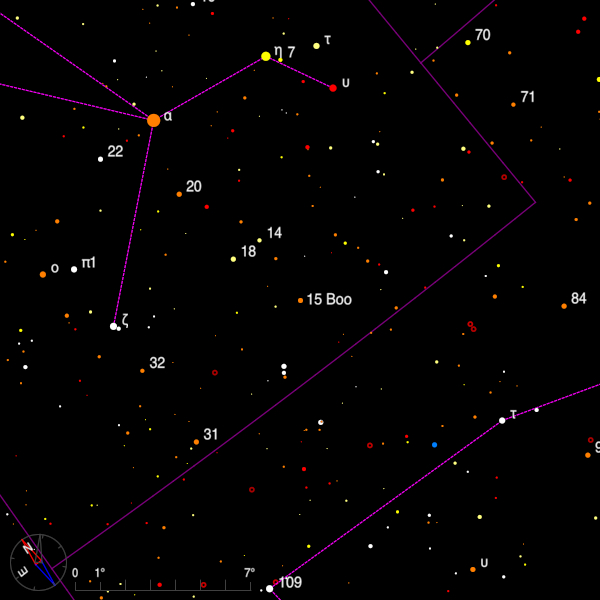
The difficulty of resolving this pair is exacervated by the difference in magnitude between the components: 5.4 and 8.4. In 2020, Dr. Marco Scardia using the 1-metre Epsilon telescope at the Plateau de Calern near Nice, found that B was itself a close visual pair: 8.4, 10.0, 175 degrees, 0".2.
In an area just north of a line drawn between theta and iota Centauri there is a rich profusion of visual double stars. One of the more interesting is HWE 28 (13 53 32.75 -35 39 51.2) a binary whose components shine at magnitudes 6.3 and 6.4. The period is 363 years and at the present time the stars are 1" apart in PA 317 degrees. An 8.7 magnitude star lies 68" away in PA 7 degrees and two much fainter stars can be seen - a 12.3 at 150 degrees 28" and a 14.8 at 133 degrees 38".

Just 1 degree due west is HWE 94 (13 48 55.07 -35 42 15.1) where the components are 6.6 and 10.2 and the separation 12" in PA 0 degrees. The HWE stars were found by Herbert A Howe, who started his career at Cincinnati Observatory, and went on to become Director of the Chamberlin Observatory which was attached to the University of Denver, Colorado. It boasted a 20-inch Clark refractor.
Bob Argyle - Double Star Section Director
February 2022 - Double Star of the Month
To the naked eye, Canis Minor is essentially two stars - Procyon and beta (or Gomeisa). In the field with Procyon is STF 1126 which has already been described in this column (Feb 2014). Starting at Gomeisa, move 1.5 degrees due south and slightly east and you will alight on eta CMi (07 28 02.1 +06 56 32), a magnitude 5.3 star. It is also known as BU 21, the low number indicating it was in the first list of discoveries, made with the famous 6-inch Clark refractor, which S W Burnham published in 1870.
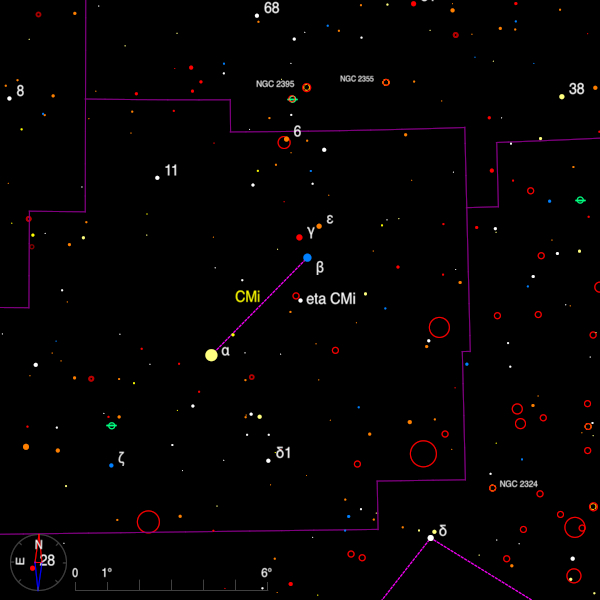
The Washington Double Star Catalog (WDS) gives the magnitude of B as 11.1 and the latest measures places it 4".3 from the bright primary. Gaia EDR3 tells us that the stars are at the same distance from us, within the errors of measurement i.e. 319 light-years, and that the proper motions are almost identical.
Two and a half degrees south of eta CMa (Aludra) is an equilateral triangle of 5th magnitude stars, the north-easterly of which is a fine triple for medium apertures and a difficult quadruple for 30-cm upwards.

The region was noted by James Dunlop at Paramatta when he saw a very wide and unequal pair of stars which he catalogued as DUN 47 (07 24 43.9 -31 48 32), and which is now given as AC in the WDS. These are 5.4 and 7.6 at 344 degrees and 97". A third star (B) was added by Bernhard Dawson observing with a 15-inch refractor at La Plata in Argentina. He noted a magnitude 9.7 just 2".2 from the primary and some years later Willem van den Bos added D, a magnitude 10.8 at 0".9 from C, a star which has not been measured since 1965.
Stars A and B have parallaxes close to 5.2 milli-arcseconds (630 light-years), whilst C and D are considerably more distant (mean parallax of 2.4 mas = 1360 light-years) and thus placing them at about the same distance as the nearby cluster Collinder 140. (This is a revised version - I'm grateful to John Greaves for pointing out an error in the original text).
Bob Argyle - Double Star Section Director
January 2022 - Double Star of the Month
phi Tauri (04 20 21.2 +27 21 03) can be found about 10 degrees north of the Hyades. Found by William Herschel, it is an attractive double star for small apertures, offering as it does, a beautiful colour contrast between the two components. The primary is a K1 giant which W. H. Smyth found to be pale red but I noted as golden yellow with a 21-cm mirror in 1968. The companion is blue and the stars are magnitudes 5.0 and 7.4.
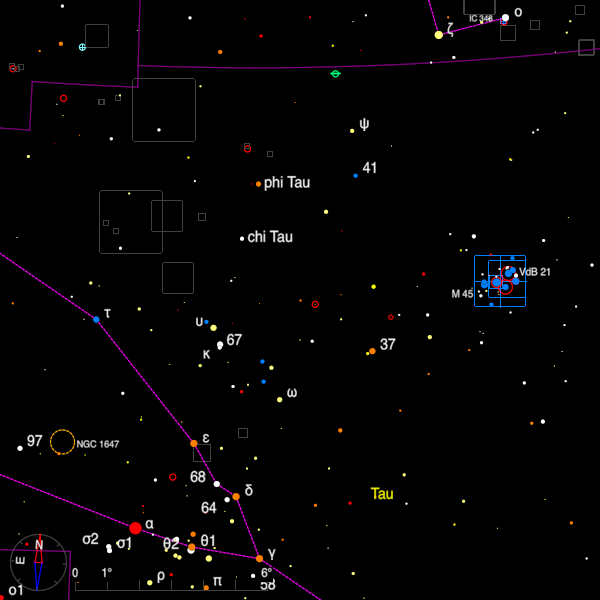
I found the position angle (PA) and separation to be 258 degrees and 48".4 in 2015 and whilst this is significantly different to the first measures of this pair, the differences are due entirely to differences in proper motion due to the differing distances to each star; 284 light-years for the primary, and 346 light-years for the secondary.
Just 2 degrees south, and slightly east of phi is chi (04 22 34.9 +25 37 45), another probably optical pair, but with magnitudes of 5.4 and 8.5, it is also well-seen in small telescopes. The stars are separated by 19" in position angle 25 degrees.
The 4.4 magnitude tau (or 30) Canis Majoris (07 18 42.49 -24 57 15.8) is at the centre of the open cluster NGC 2362. Like many stars in this region it is young, hot and very luminous and has a spectral type of 09II.

It attracts the interest of the double star observer because it appears in the catalogue of John Herschel as HJ 3948. The nomenclature applies to companions of 10.2, 11.2 and 8.2 at distances of 8".3, 14".2 and 83".5 respectively and it is of interest to the binocular observer as well as the small aperture telescope.
Tau itself, has 5 components all within 1 arc-second. Quite recently, Dr. Andrei Tokovinin found a magnitude 9.7 star nestling 0".9 away whilst in 1951, the great interferometric observer William Finsen noted another star 0".2 distant. Tau is also a tight triple star with a fainter eclipsing binary, orbiting tau itself as a spectroscopic binary with a period of 154 days.
Bob Argyle - Double Star Section Director